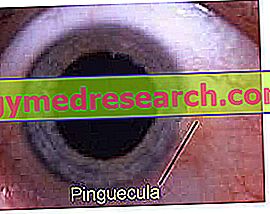What is Pinguecola?
Pinguecula is a degenerative, non-tumor formation that forms in the eye on the conjunctiva (mucous membrane that lines the eyeball and the inner part of the eyelids protecting and lubricating them).
Pinguecula appears as a small yellowish ocular growth, slightly raised.

Because of its benign nature, pinguecula rarely requires treatment. Sometimes, however, the injury can become inflamed, causing irritation and dryness; as a result, the doctor can prescribe artificial tears for lubrication and an anti-inflammatory drug to reduce swelling.
Symptoms
To learn more: Symptoms Pinguecola
In most people, the first sign of a pinguecula is the appearance of a yellowish-colored thickening on the conjunctiva; the lesion grows in relief near the cornea, which normally is not involved (and therefore differs from the pterigo). Pinguecula is more common on the side of the eye near the nose, usually in the area most exposed to sunlight. Pinguecola is a harmless lesion that causes few other symptoms. These include:
- Irritation, with sensation of a foreign body present in the eye;
- Occasional inflammation of the conjunctiva;
- Itching and redness, if the area is irritated;
- Dry eye.
In some cases, the pinguecula becomes swollen and acutely inflamed, vascularized, reddened, irritated and highly symptomatic; this condition is called pinguecolite. Irritation, burning and redness of the eyes are usually the result of exposure to sun, wind, dust or other conditions that induce extreme dryness in the eyes.
Pinguecula can increase in size over many years. This growth does not affect visual function, but can cause eye irritation. In rare cases, the lesion can gradually extend over the cornea, forming a pterygium. In the event of changes in size, shape or color, it is advisable to consult a doctor for a correct evaluation.
Causes
Pinguecula is formed by an alteration of the normal conjunctival tissue, which results in a small local deposit of protein, fat and / or calcium. The reason for this alteration is not entirely clear, but the onset has been associated with prolonged exposure to ultraviolet and infrared rays of sunlight and to factors that promote eye irritation, such as dust, wind or extremely air dry. Pinguecula is more common in middle-aged or older people, but does not spare young people and children. People who spend a lot of time in the sun, without the protection of glasses or hats, have a greater risk of developing the disorder. Susceptible groups are individuals who work outdoors, such as farmers and fishermen, or those who do outdoor activities, such as golf and gardening. Welding represents a significant professional risk. Pinguecula is frequently associated with Gaucher disease.
Diagnosis
An eye examination is often sufficient to diagnose this disorder, which is characteristic in appearance, color and position. An ophthalmologist can examine the cornea, the iris and the ocular attachments involved with a slit lamp.
Complications
A pinguecula can lead to the formation of a pterygium . These two lesions have very similar characteristics, but doctors believe that they are two distinct diseases.
A pterygium is a wedge-shaped outgrowth, which grows on the scleral conjunctiva and extends to invade the cornea, while the pinguecula, usually, does not involve the corneal area. The lesion associated with pterygium is benign (non-cancerous), but contains blood vessels and forms scar tissue on the eye (resembles a thin film that grows above the eye). If it increases excessively in size or thickness, it can interfere with vision: a fairly large pterygium can actually cause a distortion of the corneal surface, leading to astigmatism.
A pterygium can often develop from a pinguecula and this evolution is favored by prolonged exposure to ultraviolet light from the sun.
Treatment
Pinguecula generally does not require any treatment, unless it causes severe symptoms. A conservative approach is recommended for most patients: lubrication with artificial tears can relieve dryness and eye irritation and sometimes, temporary use of mild steroid eye drops may be useful to reduce inflammation.
Rarely, these growths become large enough to interfere with vision or cause persistent discomfort. In these cases, the pinguecula can be surgically removed.
Surgery is considered when a pinguecule:
- It extends over the cornea (if it is large enough it can involve the central visual area of the cornea or cause astigmatism);
- It causes extreme discomfort when trying to wear contact lenses;
- It is constantly and severely inflamed, even after the application of eye drops or ointments.
Sometimes the lesions are also removed for aesthetic reasons.
Surgery can be performed on an outpatient basis, with local anesthesia. Generally, recovery takes many weeks and involves applying eye drops or topical ointments prescribed several times a day. Surgery usually does not lead to complications, but pinguecula tends to recur.
The best way to avoid repetition of the lesion, after treatment, is to limit exposure to environmental factors that facilitate growth (such as direct exposure to sunlight, irritants and dusty environments). In dry eye conditions, applying artificial tears and decongesting eye drops can prevent swelling and irritation.



